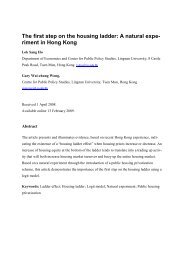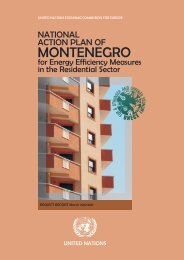housing developments in european countries - Department of ...
housing developments in european countries - Department of ...
housing developments in european countries - Department of ...
Create successful ePaper yourself
Turn your PDF publications into a flip-book with our unique Google optimized e-Paper software.
Section 1<br />
Introduction and Summary<br />
Introduction and Summary Section 1<br />
outl<strong>in</strong>es the pr<strong>in</strong>cipal aims <strong>of</strong> <strong>hous<strong>in</strong>g</strong> policy at the<br />
National Report on Hous<strong>in</strong>g Developments <strong>in</strong><br />
■ <strong>hous<strong>in</strong>g</strong> policy issues, such as arrangements for<br />
To some extent this divergence <strong>in</strong> GDP per capita is<br />
current time, together with the arrangements for policy<br />
European Countries – Responses to the Questionnaire<br />
<strong>hous<strong>in</strong>g</strong> policy development and implementation<br />
counterbalanced by variations <strong>in</strong> annual growth <strong>in</strong><br />
development and implementation and the characteris-<br />
Survey.<br />
and recent <strong>hous<strong>in</strong>g</strong> policy <strong>developments</strong>, and<br />
GDP. TABLE 1.4.1 <strong>in</strong>dicates that the GDP <strong>of</strong> the 28<br />
tics <strong>of</strong> the <strong>hous<strong>in</strong>g</strong> stock <strong>in</strong> each <strong>of</strong> the 28 <strong>countries</strong><br />
under exam<strong>in</strong>ation. The most significant contemporary<br />
economic and demographic trends pert<strong>in</strong>ent to <strong>hous<strong>in</strong>g</strong><br />
are also exam<strong>in</strong>ed. SECTION 3 sketches recent <strong>hous<strong>in</strong>g</strong><br />
policy and legislative and <strong>in</strong>stitutional <strong>developments</strong> <strong>in</strong><br />
European <strong>countries</strong> and exam<strong>in</strong>es the issues that are<br />
the subject <strong>of</strong> national <strong>hous<strong>in</strong>g</strong> policy debates and are<br />
When <strong>hous<strong>in</strong>g</strong> m<strong>in</strong>istries were unable to produce the<br />
data necessary to complete all Sections <strong>of</strong> this report,<br />
the requisite <strong>in</strong>formation was generated by the authors<br />
from 4 other sources. These are:<br />
■ the Eurostat – long-term <strong>in</strong>dicators series –<br />
‘People <strong>in</strong> Europe’;<br />
■ the outcomes produced by the comb<strong>in</strong>ation <strong>of</strong> these<br />
policy <strong>in</strong>terventions and structural factors, <strong>in</strong>clud<strong>in</strong>g<br />
trends <strong>in</strong> <strong>hous<strong>in</strong>g</strong> demand and supply, <strong>hous<strong>in</strong>g</strong> costs<br />
and public expenditure on <strong>hous<strong>in</strong>g</strong>.<br />
1.4.1 Context<br />
<strong>countries</strong> under exam<strong>in</strong>ation grew by 2.8%. This falls<br />
to 1.7% <strong>in</strong> the case <strong>of</strong> the 15 long-stand<strong>in</strong>g EU<br />
members, but rises to 4.6% for the 10 <strong>countries</strong> which<br />
acceded to EU membership <strong>in</strong> 2004. At the same time,<br />
unemployment and <strong>in</strong>flation rates are generally higher<br />
<strong>in</strong> the new EU member States. Among the 28 <strong>countries</strong><br />
under exam<strong>in</strong>ation annual <strong>in</strong>flation averages at 3.4%,<br />
currently <strong>of</strong> key concern to <strong>hous<strong>in</strong>g</strong> m<strong>in</strong>isters. This<br />
Section also scrut<strong>in</strong>ises changes <strong>in</strong> regulations on<br />
build<strong>in</strong>g standards and reports on EU and<br />
<strong>in</strong>ternational <strong>developments</strong> which have implications<br />
for <strong>hous<strong>in</strong>g</strong> policy <strong>in</strong> European <strong>countries</strong>. SECTION 4<br />
exam<strong>in</strong>es the outcomes <strong>of</strong> the <strong>hous<strong>in</strong>g</strong> policy<br />
<strong>developments</strong> <strong>in</strong> European <strong>countries</strong> which were<br />
described <strong>in</strong> the previous Section. Recent macro and<br />
micro trends <strong>in</strong> the demand for and the supply <strong>of</strong><br />
<strong>hous<strong>in</strong>g</strong> are scrut<strong>in</strong>ised, as are difficulties <strong>in</strong> match<strong>in</strong>g<br />
supply and demand, together with the measures which<br />
have been <strong>in</strong>itiated to address these difficulties, if any.<br />
Trends <strong>in</strong> <strong>hous<strong>in</strong>g</strong> affordability across Europe are<br />
outl<strong>in</strong>ed and <strong>developments</strong> <strong>in</strong> relation to the<br />
ma<strong>in</strong>tenance and improvement <strong>of</strong> the <strong>hous<strong>in</strong>g</strong> stock<br />
and the sale <strong>of</strong> social <strong>hous<strong>in</strong>g</strong> are reviewed.<br />
1.3 Research Methods<br />
Most <strong>of</strong> the <strong>in</strong>formation <strong>in</strong> this report was collated<br />
from the results <strong>of</strong> a questionnaire which was<br />
circulated <strong>in</strong> February 2004 by the Irish <strong>Department</strong> <strong>of</strong><br />
the Environment, Heritage and Local Government to<br />
the <strong>hous<strong>in</strong>g</strong> focal po<strong>in</strong>ts <strong>in</strong> the 28 <strong>countries</strong> under<br />
exam<strong>in</strong>ation. APPENDIX 1 to this report <strong>in</strong>cludes details<br />
<strong>of</strong> the representatives <strong>of</strong> <strong>hous<strong>in</strong>g</strong> m<strong>in</strong>istries – known as<br />
<strong>hous<strong>in</strong>g</strong> focal po<strong>in</strong>ts – who participated <strong>in</strong> this<br />
exercise. The questionnaire employed <strong>in</strong> this research is<br />
similar <strong>in</strong> content to the questionnaires on which the<br />
previous synthesis reports on Hous<strong>in</strong>g Developments<br />
<strong>in</strong> European Countries, referred to above, were based.<br />
A copy <strong>of</strong> the questionnaire is <strong>in</strong>cluded <strong>in</strong> APPENDIX 2<br />
to this report, while the responses which the various<br />
European <strong>countries</strong> made to the questionnaire survey<br />
■ the Regular National Report on Hous<strong>in</strong>g<br />
Developments <strong>in</strong> European Countries produced<br />
by Belgium <strong>in</strong> 2002;<br />
■ Hous<strong>in</strong>g Statistics <strong>in</strong> the EU 2002, which was<br />
produced by the <strong>Department</strong> <strong>of</strong> Hous<strong>in</strong>g <strong>of</strong> the<br />
Direction General <strong>of</strong> Plann<strong>in</strong>g, Hous<strong>in</strong>g and<br />
Heritage <strong>of</strong> the Walloon Region <strong>of</strong> Belgium, and<br />
■ UNECE (2002) Annual Bullet<strong>in</strong> <strong>of</strong> Hous<strong>in</strong>g and<br />
Build<strong>in</strong>g Statistics for Europe and North America,<br />
Vol. XLI (Geneva: United Nations Economic<br />
Commission for Europe).<br />
Compar<strong>in</strong>g <strong>hous<strong>in</strong>g</strong> <strong>developments</strong> <strong>in</strong> such a wide<br />
variety <strong>of</strong> <strong>countries</strong> is a challeng<strong>in</strong>g task. Comparable<br />
data were not always available for all <strong>of</strong> the <strong>countries</strong><br />
under exam<strong>in</strong>ation. For this reason, the <strong>in</strong>formation<br />
presented <strong>in</strong> some <strong>of</strong> the tables <strong>in</strong> this report does not<br />
add up to 100%. Moreover, <strong>in</strong> some cases, the<br />
term<strong>in</strong>ology used may have an entirely different<br />
mean<strong>in</strong>g <strong>in</strong> different <strong>countries</strong>. In order to address this<br />
latter problem, a comprehensive glossary is <strong>in</strong>cluded,<br />
expla<strong>in</strong><strong>in</strong>g the key terms and abbreviations employed<br />
<strong>in</strong> this report.<br />
1.4 Summary<br />
This Section summarises the most significant recent<br />
<strong>hous<strong>in</strong>g</strong> <strong>developments</strong> <strong>in</strong> European <strong>countries</strong> which are<br />
identified <strong>in</strong> this report. This synopsis is divided <strong>in</strong>to<br />
three parts. These are:<br />
■ the context for <strong>hous<strong>in</strong>g</strong> policy-mak<strong>in</strong>g, <strong>in</strong>clud<strong>in</strong>g:<br />
economic and demographic trends pert<strong>in</strong>ent to<br />
<strong>hous<strong>in</strong>g</strong> and the size and characteristics <strong>of</strong> the<br />
TABLE 1.4.1 outl<strong>in</strong>es recent economic and demographic<br />
trends pert<strong>in</strong>ent to <strong>hous<strong>in</strong>g</strong> <strong>in</strong> the 28 <strong>countries</strong> under<br />
exam<strong>in</strong>ation <strong>in</strong> the latest year for which data are<br />
available.<br />
In this table, the GDP per capita (<strong>in</strong> Purchas<strong>in</strong>g Power<br />
Standards) among the 28 <strong>countries</strong> under review is<br />
ranked <strong>in</strong> accordance with the average for the 25 EU<br />
member States, which is set at 100. TABLE 1.4.1 reveals<br />
that, <strong>in</strong> the latest year for which data are available,<br />
Luxembourg had by far the highest GDP per capita<br />
among the <strong>countries</strong> under exam<strong>in</strong>ation, while Ireland<br />
and Denmark respectively have the second and third<br />
highest levels <strong>of</strong> GPD per capita. In contrast, the<br />
applicant <strong>countries</strong> – Turkey, Bulgaria and Romania –<br />
have the lowest GDP per capita among the <strong>countries</strong><br />
under exam<strong>in</strong>ation.<br />
This table also highlights a disparity between the<br />
average GDP per capita <strong>of</strong> the 15 long-stand<strong>in</strong>g EU<br />
member States and the new member States. Among the<br />
15 long-stand<strong>in</strong>g EU member States, GDP per capita<br />
averages at 116.6, whereas the equivalent figure for the<br />
10 new member States is 60.3. However, more detailed<br />
analysis reveals that the latter figure is significantly<br />
<strong>in</strong>flated by Malta and Cyprus, because <strong>in</strong> both <strong>of</strong> these<br />
<strong>countries</strong> the GDP per capita is significantly above the<br />
average for the 10 new EU member States. The average<br />
GDP per capita among the 8 Central and Eastern<br />
European (CEE) <strong>countries</strong> which jo<strong>in</strong>ed the EU <strong>in</strong> 2004<br />
(i.e. the Czech Republic, Estonia, Hungary, Latvia,<br />
Lithuania, Poland, Slovakia and Slovenia) is 53.<br />
Although it is important to acknowledge that the GDP<br />
<strong>of</strong> these <strong>countries</strong> does also vary significantly.<br />
but the equivalent figures for the 15 long-stand<strong>in</strong>g EU<br />
members and the 10 new EU members are 2.3% and<br />
3.6% respectively.<br />
TABLE 1.4.1 also highlights some recent demographic<br />
<strong>developments</strong> that have significant implications for<br />
<strong>hous<strong>in</strong>g</strong> <strong>in</strong> the <strong>countries</strong> under exam<strong>in</strong>ation. For<br />
<strong>in</strong>stance, <strong>in</strong> recent years population change has been<br />
low <strong>in</strong> the majority <strong>of</strong> European <strong>countries</strong>, and has<br />
been negative <strong>in</strong> several <strong>of</strong> the new member States and<br />
applicant <strong>countries</strong>. Among the 28 <strong>countries</strong> under<br />
review, natural population change per 1,000<br />
<strong>in</strong>habitants averages at 1.2, while net migration per<br />
1,000 <strong>in</strong>habitants averages at 2. In the 15 longstand<strong>in</strong>g<br />
EU members natural population change<br />
averages at 1.7. This falls to –0.7 among the 10 new<br />
EU member States, and to –2.6 among the 8 Central<br />
and Eastern European <strong>countries</strong> which jo<strong>in</strong>ed the EU<br />
<strong>in</strong> 2004. Table 1.4.1 reveals similar patterns <strong>in</strong> net<br />
migration per 1,000 <strong>in</strong>habitants. In Latvia, Lithuania<br />
and Romania emigration has exceeded immigration <strong>in</strong><br />
recent years.<br />
TABLE 1.4.1 demonstrates that the average household<br />
size among the 28 <strong>countries</strong> under review is 2.6<br />
persons. Unlike many <strong>of</strong> the other economic and<br />
demographic issues mentioned above, average<br />
household size does not vary significantly between the<br />
new and long-stand<strong>in</strong>g EU member States. Average<br />
household size is highest <strong>in</strong> Spa<strong>in</strong>, Malta and Cyprus,<br />
while it is lowest <strong>in</strong> Germany and Denmark. Moreover,<br />
Section 2 <strong>of</strong> this report reveals that, <strong>in</strong> many <strong>of</strong> the<br />
<strong>countries</strong> where average household size has<br />
traditionally been high, it has fallen significantly <strong>in</strong><br />
recent years.<br />
are recorded <strong>in</strong> a separate document entitled Regular<br />
<strong>hous<strong>in</strong>g</strong> stock;<br />
2 European Union Report<br />
Regular National Report on Hous<strong>in</strong>g Developments <strong>in</strong> European Countries<br />
3

















